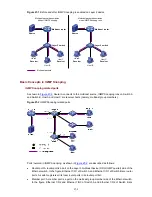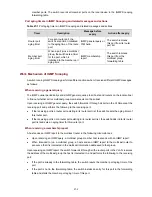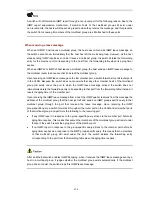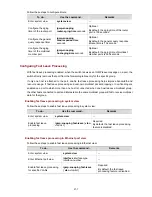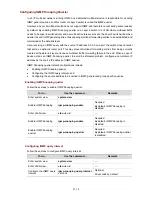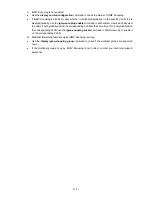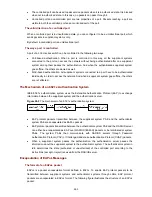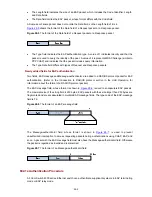
27-16
To do...
Use the command...
Remarks
Specify the VLANs to be
allowed to pass the port
port hybrid
vlan
vlan-id-list
{
tagged
|
untagged
}
Required
The multicast VLAN must be
included, and the port must be
configured to forward tagged
packets for the multicast VLAN.
z
One port can belong to only one multicast VLAN.
z
The port connected to a user terminal must be a hybrid port.
z
The multicast member ports must be in the same VLAN with the router port. Otherwise, the
multicast member port cannot receive multicast packets.
z
If a router port is in a multicast VLAN, the router port must be configured as a trunk port or a hybrid
port that allows tagged packets to pass for the multicast VLAN. Otherwise, all the multicast
member ports in this multicast VLAN cannot receive multicast packets.
z
The multicast VLAN function and the VLAN mapping function cannot be configured at the same
time.
Displaying and Maintaining IGMP Snooping
To do...
Use the command…
Remarks
Display the current IGMP
Snooping configuration
display igmp-snooping
configuration
Available in any view
Display IGMP Snooping
message statistics
display igmp-snooping
statistics
Available in any view
Display the information about
IP and MAC multicast groups in
one or all VLANs
display igmp-snooping
group
[
vlan
vlan-id
]
Available in any view
Clear IGMP Snooping statistics
reset igmp-snooping
statistics
Available in user view
IGMP Snooping Configuration Examples
Configuring IGMP Snooping
Network requirements
To prevent multicast traffic from being flooded at Layer 2, enable IGMP snooping on Layer 2 switches.
z
As shown in
Figure 27-3
, Router A connects to a multicast source (Source) through Ethernet 1/0/2,
and to Switch A through Ethernet 1/0/1.
z
Run PIM-DM and IGMP on Router A. Run IGMP snooping on Switch A. Router A acts as the IGMP
querier.
z
The multicast source sends multicast data to the multicast group 224.1.1.1. Host A and Host B are
receivers of the multicast group 224.1.1.1.

